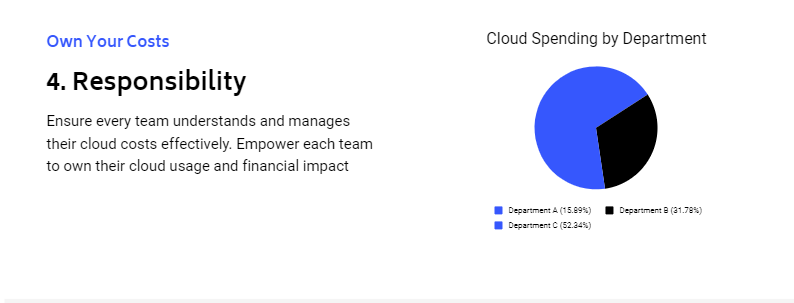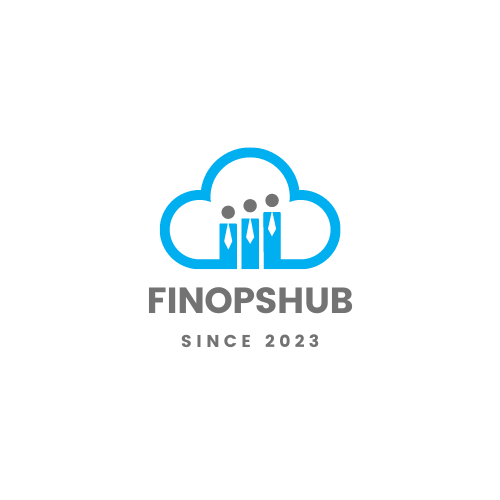Table of Contents
What is FinOps Anyway?
FinOps, short for Financial Operations, is all about getting the most bang for your buck when it comes to cloud spending. It’s a mix of finance and tech working together to make sure every dollar counts.
According to Amnic, FinOps makes everyone responsible for their cloud costs, so no one’s just throwing money around. It’s like giving each team their own budget to manage, making them think twice before splurging.
The Evolution of FinOps and Its Role in Cloud Finance
FinOps, or Financial Operations, has come a long way since its inception, transforming from a niche financial practice into a crucial component of modern cloud finance management.
Initially focused on basic cost tracking, FinOps now integrates finance, technology, and operations to provide a comprehensive approach to managing cloud expenses. As cloud technology has evolved, so too has FinOps, adapting to more sophisticated financial strategies and tools.
Today, FinOps plays a pivotal role in optimizing cloud spending, ensuring transparency, and driving accountability across teams. Its evolution reflects the growing complexity of cloud environments and the need for strategic financial oversight in an increasingly digital world.
How FinOps Principles Align with Business Goals
FinOps principles are the secret sauce for keeping cloud costs in check. They make sure everyone knows what’s being spent, find ways to save without cutting corners, and get everyone on the same page. If companies stick to these fundamental practices, they can prevent wasteful spending and make smarter financial choices.
Here’s the lowdown on some key FinOps principles:


Cloud Cost Management Stats
How Cloud Repartitioning Saves You Money
Managing cloud costs is a big deal for businesses diving into cloud tech. Repartitioning your cloud resources can make a huge difference in your expenses. According to G2, you can slash costs by 50% just by smartly allocating and optimizing your cloud resources. Imagine cutting your cloud bill in half!
| Parameter | Cost Reduction (%) |
|---|---|
| Cloud Repartitioning | 50 |
| Cloud Migration | 53 |
| General Cost Savings | 40-60 |
And it gets better. Worldmetrics.org says that up to 74% of businesses have successfully cut costs by using cloud services. Just moving to the cloud can save you up to 53%.
The Struggle with Cloud Expense
Even with all these savings, many companies still have a hard time keeping track of their cloud costs. G2 found that 40% of companies take days, weeks, or even months to get an updated view of their cloud expenses. This lag can mess up your cost management and resource efficiency plans.
| Time to Update Cloud Costs | Percentage of Companies (%) |
|---|---|
| Days, Weeks, or Months | 40 |
Without real-time visibility, managing costs becomes a nightmare. It’s tough to spot inefficiencies and optimize resources. But don’t worry, adopting FinOps practices, like FinOps principles and using cloud cost management platforms, can give you better insights and control over your cloud spending. Learning how to track cloud expenses with FinOps tools’ allows companies to gain real-time insights and better control over their cloud spending.
Want more tips on cutting cloud costs? Check out our article on 10 cloud cost reduction strategies and learn about rightsizing cloud resources.
Getting a grip on where cloud tech is now and where it’s headed is key to keeping your cloud finances in check and making the most of FinOps principles.
What’s Happening with Cloud Adoption?
Cloud tech is booming. Over 90% of companies are on board, with 1 in 5 running 75% of their stuff in the cloud (O’Reilly). Why? Because it’s scalable, flexible, and saves money on IT.
| Metric | Percentage |
|---|---|
| Companies using the cloud | 90% |
| Companies with 75% cloud-based workloads | 20% |
| Companies expecting 75% cloud-based workloads by 2023 | 31% |
| Big companies with cloud adoption | 94% |
Spending on cloud services is also shooting up. In 2021, it hit $421 billion and is expected to reach nearly $600 billion by 2023 (Gartner). This shows just how much businesses are leaning on the cloud for their operations.

What’s Next for Cloud Adoption?
The cloud trend isn’t slowing down. By 2023, 31% of companies expect to have 75% of their workloads in the cloud (RightScale). Plus, 71% of companies plan to spend even more on cloud services (Flexera).
| Metric | Percentage |
|---|---|
| Companies expecting increased cloud spend | 71% |
| IT spending still traditional in 2023 | 58.7% |
| Corporate budgets invested in cloud tech by 2025 | 65% |
By 2025, around 65% of corporate budgets will go into cloud tech, highlighting the need for smart financial software to keep up with market changes and stay ahead (Computools). This shift means businesses need solid cost management strategies, like FinOps, to get the best bang for their buck.
Want to save on cloud costs? Check out 10 cloud cost reduction strategies, rightsizing cloud resources, and cloud budgeting and forecasting.
Implementing FinOps
Getting FinOps up and running in your organization isn’t rocket science, but it does need some elbow grease and teamwork. For small businesses looking to implement FinOps effectively, focusing on tailored strategies like ‘how to implement FinOps for small businesses’ can lead to more manageable cloud cost management.
Here’s a no-nonsense guide to making it happen, with a spotlight on who needs to do what.
Steps to Get FinOps Rolling
Get Everyone on Board: You need folks from finance, IT, and operations to join the party early. This way, everyone’s on the same page from the get-go (Amnic).
Set Clear Goals: Know what you want to achieve with FinOps. Make sure these goals fit with your company’s overall game plan.
Create a Governance Plan: Lay down the rules for how you’ll manage cloud costs. This includes policies for cloud usage, cost allocation, and reporting.
Budget Smartly: Set up a budgeting system that includes cloud costs. This helps you keep tabs on spending and plan for future expenses.
Assign Costs to Teams: Make sure different teams or business units own their cloud costs. This keeps everyone accountable and encourages smarter spending (Amnic).
Use FinOps Tools: Leverage tools and platforms to get a clear view of your cloud spending, optimize resources, and generate detailed reports. Check out our article on cloud cost management platforms for more info.
| Step | What to Do |
|---|---|
| Get Everyone on Board | Bring in finance, IT, and operations teams early. |
| Set Clear Goals | Align with your company’s strategies. |
| Create a Governance Plan | Set rules for cloud usage and cost management. |
| Budget Smartly | Track spending and plan for future costs. |
| Assign Costs to Teams | Make teams responsible for their cloud costs. |
| Use FinOps Tools | Get visibility and optimize spending. |
Who Does What in FinOps
Executives: They set the direction and make sure FinOps fits with the big picture. Their backing is crucial for getting the resources you need.
Business/Product Owners: They manage cloud resources and make cost-effective decisions. Their role is key in cutting down waste and optimizing usage.
Engineering and Operations Teams: These folks build and maintain the cloud infrastructure. Their tech skills are vital for spotting ways to save money and use resources better.
FinOps Practitioners: They’re the glue between finance, IT, and operations. They keep everyone talking, track spending, and make sure the numbers add up.
Finance/Procurement Teams: They handle budgets, monitor spending, and ensure everything’s above board. They work closely with other teams to develop cost models and keep cloud spending in check (Spot.io).
| Stakeholder | Role |
|---|---|
| Executives | Set direction and secure resources. |
| Business/Product Owners | Manage resources and optimize usage. |
| Engineering and Operations Teams | Build and maintain infrastructure. |
| FinOps Practitioners | Connect finance, IT, and operations. |
| Finance/Procurement Teams | Handle budgets and ensure compliance. |
By following these steps and getting the right people involved, you can make FinOps work for your organization. For more tips, check out our articles on FinOps principles and the FinOps framework.
What is FinOps Best Practices
The FinOps Foundation has laid out six key principles to keep your cloud costs in check and your financial management on point.
- Teamwork: Get your engineering, finance, and business folks working together.
- Transparency: Make sure everyone can see the cloud cost data.
- Responsibility: Hold specific teams accountable for their cloud expenses.
- Regular Reports: Keep those financial reports coming.
- Central Control: Manage cloud costs from a central point for better oversight.
- Continuous Improvement: Always look for ways to cut costs and boost efficiency.
Applying FinOps best practices for optimizing cloud spending ensures that your cloud cost management strategy is both comprehensive and effective.
Phases of FinOps Implementation
Getting FinOps up and running is a journey. Think of it like learning to walk before you run. The FinOps Foundation breaks it down into three main phases: Inform, Optimize, and Operate. These steps are ongoing and always evolving.
Inform
First up, you need to get a handle on your cloud costs. Here’s how:
- Cost Allocation: Make sure costs are assigned to the right teams or projects.
- Tagging Resources: Use multi-cloud tagging best practices to keep track of everything.
- Reporting: Create detailed reports for everyone who needs to see them.
Optimize
Next, it’s time to trim the fat and make things more efficient. Key moves include:
- Rightsizing Resources: Adjust resource allocation to fit actual usage (rightsizing cloud resources).
- Cost-Saving Options: Use reserved instances vs on-demand pricing and spot instances and preemptible VMs.
- Eliminating Waste: Find and eliminate cloud waste.
| Optimization Technique | Expected Savings (%) |
|---|---|
| Rightsizing Resources | 10-30% |
| Reserved Instances | 20-50% |
| Spot Instances | 70-90% |
Operate
Finally, keep the good times rolling by maintaining and improving your practices:
- Automation: Automate routine tasks to save time.
- Continuous Monitoring: Keep an eye on cost and usage data regularly.
- Stakeholder Engagement: Make sure everyone stays in the loop and works together.
For more tips on getting FinOps right, dive into our FinOps framework.
Mastering these fundamental practices and phases can seriously boost your cloud financial management, aligning your financial strategies with your operational goals. For some practical tips, check out our article on 10 cloud cost reduction strategies.
Keeping Cloud Costs in Check
Managing cloud costs isn’t just about saving money—it’s about making sure you’re getting the most bang for your buck. Let’s break down how to cut down on cloud waste and why nailing your cost forecasts is a game-changer.
Cutting Down on Cloud Waste
Cloud waste happens when you’re paying for stuff you don’t need. Think of it like leaving the lights on in an empty room. A whopping 88% of companies admit they’re wasting money on the cloud (CloudZero). Here’s how to stop that:
- Rightsizing Cloud Resources: Regularly check and tweak your cloud resources to fit what you’re actually using. Need help? Check out our guide on rightsizing.
- Using Reserved and Spot Instances: Save cash by opting for reserved instances instead of on-demand ones, and make use of spot instances for even more savings.
- Multi-Cloud Tagging: Keep tabs on your resources with multi-cloud tagging.
- Regular Cost Audits: Periodically review your cloud usage to spot and fix waste. Dive deeper into eliminating cloud waste.
Nailing Cost Forecasts
Getting your cloud cost forecasts right is like having a crystal ball for your budget. Many teams struggle with this because they don’t have enough data (CloudZero). Here’s how to get it right:
- Cloud Cost Management Platforms: Use cloud cost management tools to see where your money’s going and predict future costs.
- Chargeback and Show-Back Models: Allocate costs to the right departments with chargeback and show-back models.
- Unit Economics: Understand unit economics to see if your cloud spending is worth it.
- Total Cost of Ownership (TCO) Analysis: Look at the long-term costs and benefits with TCO analysis.
- Cloud Budgeting: Set and stick to a detailed budget. Learn more about cloud budgeting and forecasting.
| Strategy | Benefit |
|---|---|
| Rightsizing Resources | Cuts down on over-provisioning |
| Reserved Instances | Cheaper than on-demand pricing |
| Spot Instances | Uses cost-effective, unused capacity |
| Multi-Cloud Tagging | Better resource tracking |
| Regular Cost Audits | Finds and fixes waste |
By following these tips, you’ll not only save money but also make sure your cloud spending aligns with your business goals. For more on FinOps, check out our articles on finops principles and finops framework.





